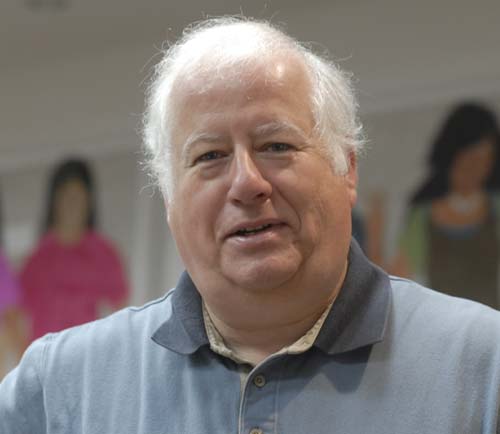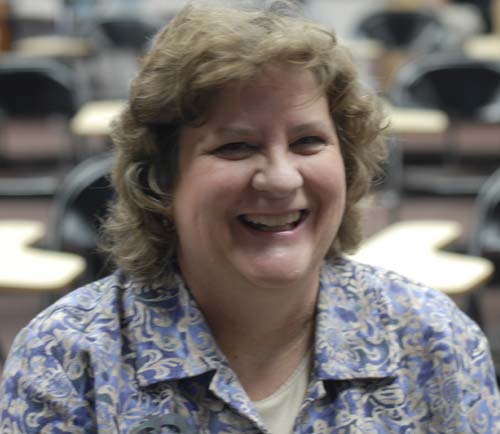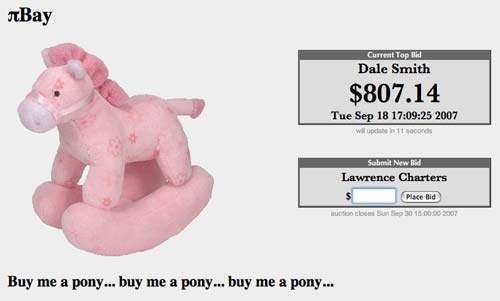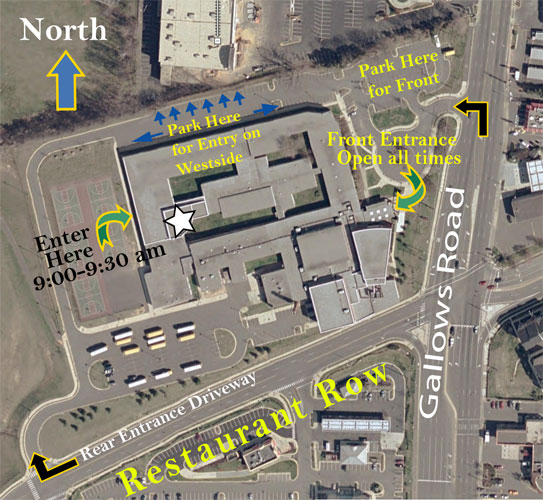



September 2007 General Meeting photos
In July 2007, the Pi held a very successful introduction to creating Web pages, aimed at beginners, featuring iWeb 1.0. September saw us aim higher, introducing Sandvox, an inexpensive Web editing package that has won a number of design awards, and Dreamweaver, widely regarded as the most powerful and influential Web editing package ever created. In the space of a few months, Pi members could see a range of tools that have together transformed the world and brought about the biggest revolution in publishing since movable type.

Lawrence Charters handled the monthly Question and Answer session. Photo by Dick Sanderson.
During the opening Q&A session, one of the first questions was about iWeb, and the recently released iWeb 2.0. Was this new package, part of iLife ’08, a significant advance over the previous version, demonstrated in July? Lawrence Charters, the Q&A moderator, answered with a strong “yes!” and showed off a set of pages he created using iWeb 2.0. He did note, however, that he uses iWeb 2.0 for very specific tasks, and does most of his Web work using Adobe’s Dreamweaver. He also noted this was his preference rather than a requirement, as he preferred Dreamweaver’s site management tools.
Another interesting question, asked before the meeting, concerned booting from a FireWire drive. Rather than take a desktop computer for a demonstration, a member created a bootable FireWire drive, tested the drive (it booted perfectly), but found it would not boot when he reached his destination. The problem: the bootable drive was assembled on a PowerPC-based Power Mac G5, and it failed on an Intel-based MacBook. As it happens, Intel-based machines use very different boot partitions from FireWire drives, and what works for a PowerPC-based machine won’t work for an Intel-based Mac. There are ways around this, but they are complex; spelunking in Mac OS X Hints (http://www.macosxhints.com/) reveals several approaches.
Another question dealt with importing addresses into Mac OS X’s Address Book. Address Book looks innocent enough, but it is a powerful database in its own right, and can be used by a wide variety of Mac OS X programs beyond Mail. Versiontracker (http://www.versiontracker.com/) lists a huge number of utilities – commercial, shareware, and freeware – that can import data into Address Book from Excel spreadsheets, FileMaker, Netscape, Eudora, and other sources.
There were a couple questions about the iPhone (short answer: it is a phone, and if you want it to function as a phone, don’t hack it; the FCC doesn’t like that) and Mac OS X 10.5, code-named “Leopard.” Lawrence expressed great hope that Leopard would be released sometime around his birthday (in October) but otherwise was mum.
After welcoming new members and visitors, Pi President Bob Jarecke reviewed a proposed change to the Pi Bylaws concerning fiscal controls. Kathleen Charters moved to accept the amendment, the motion was seconded by Marty Ditmeyer, and the amendment passed unanimously. The Bylaws are posted in full on the Pi Web site; the amendment was specific to Article XII, Section 1: http://www.wap.org/about/
Unrelated to the Bylaws but very much related to the meeting topic, Bob mentioned that the Board increased Pi member Web storage allotments in June (every member now has at least 25 MB of Web storage space). Since this increase, member Web usage has risen 40%.

Dick Rucker talked about Karelia Software's Sandvox. Photo by Dick Sanderson.
Dick Rucker, Pi Treasurer emeritus, guided the first presentation, on Karelia Software’s Sandvox. Karelia bills it as a tool for “Easy, Elegant Website Creation,” and it was a 2007 Apple Design Award nominee for “Best Mac OS X User Experience.” Sandvox is a Mac-only tool that makes excellent use of Mac OS X; users of Pages, Keynote, Numbers and (ironically) iWeb will find the interface very familiar. Karelia’s own site was built with Sandvox (http://www.karelia.com/), which should give you some inkling of what the package can do.
Rucker obviously did a great deal of preparation for the presentation, and spoke at length on his editing experience prior to Sandvox and how much better things were since he adopted the package. He also talked about Karelia extensively, including some gossip about the company founders and some ongoing disputes they have with Apple. He prepared a collection of “Sandvox Goodies,” consisting of a script to help upload pages to Pi member’s Web sites on members.wap.org, and a PDF of “Dick Rucker’s notes on Sandvox;” the goodies can be downloaded from the Pi Web site.
Dick even arranged for a limited-time Pi member discount on Sandvox. Go to Karelia’s Web site, press the “Buy Now” menu button, and type “muggle” (without quotes) into the Coupon Code box, and you’ll get a 25% discount on either Sandvox or Sandvox Pro.
Dick spent so much time talking about Sandvox that he never quite
got around to demonstrating it, but the package is a template-based graphical
Web editing package, in many ways more flexible and extensible than Apple’s iWeb,
yet not appreciably less difficult to use. Dick showed his own site, for
a chapter of The Quarter Century Wireless Association (QCWA), and the difference
pre-Sandvox:
http://homepage.mac.com/rrucker/qcwa/chapter91.html
and post-Sandvox:
http://homepage.mac.com/rrucker/chapter91/
is quite striking.
In the interregnum between the two presentations, everyone broke into clusters to talk about Sandvox and Dreamweaver, continue the Q&A discussions, or drink coffee and eat donuts. There was much discussion of the iPhone, the new iPod touch, and the relative merits of each (both were considered great gadgets; the controversy centered on which one to get). Similar discussions debated getting a new Mac now or waiting for Leopard; it was quite apparent that the Pi is chock full of cat lovers. Bob Jarecke almost had to resort to magic tricks to bring the meeting back to order.

Mindy Nash provided an excellent overview of Dreamweaver. Photo by Dick Sanderson.
By the time Mindy Nash took the stage for the second presentation on Dreaweaver, the meeting was seriously time constrained. Mindy had a huge subject to cover and very little time, and immediately dove right in.
Mindy started out as an office manager and IT person for Georgetown University’s Maternal and Child Health Group, and aside from training people how to use their Macs, had little to do with creating Web sites – until 2003, when the Webmaster left and she was given the job. Though she has since taken a couple Dreamweaver classes, she is mostly self-taught, “and there is still much to learn.” Dreamweaver, unlike iWeb or Sandvox, is not normally used with canned templates (though that is an option); instead, a Web designer is given a blank slate, full of endless possibilities, limited only by the needs of the site and the talent of the designer. You can see Mindy’s work – done in Dreamweaver – on the Maternal and Child Health Group’s Web site, http://www.mchgroup.org/
First released in 1997, Dreamweaver is the reigning champion Web editing package. More Web sites are edited with Dreamweaver than with any other package, in both the Windows and the Mac worlds. The package is so highly esteemed by serious Webmasters and Web designers that Dreamweaver, almost alone, rescued Macromedia (the original publisher) from financial difficulties, and was the prize in Adobe’s purchase of Macromedia in 2005.
As Mindy walked us quickly through the menus, covering virtually every aspect of Web design, the vast scope of Dreamweaver was obvious. In addition to plain old HTML, the stuff of most Web sites, you can create cutting-edge XHTML, or design pages in PHP, or ColdFusion, or ASP VBScript, or ASP .NET, or JavaScript, or XML, or XSALT, or whatever else you might dream up. Dreamweaver can draw on a library of CSS style sheets, as well as a wealth of “starter pages” and other templates.
You can also program in raw HTML code, with automatic code-completion compliments of Dreamweaver. It automatically flags syntax problems, in both the graphical interface as well as the code view, and has a robust spelling checker. One thing it does not do is resize photos for the Web, something that iWeb does easily. On the other hand, Dreamweaver integrates very well with Adobe Photoshop, providing great flexibility in handling of graphics.
Mindy prepared some oustanding sample pages done in Dreamweaver that, among other things, have a wealth of links to Web design resources.
Before closing Bob Jarecke quickly covered some other subjects. A new Web-based survey is in the works, this one on Pi Benefits. He also mentioned that there are two open positions on the Board of Directors; if you’d like to help lead the Pi, send him an E-mail: president@wap.org.

πBay: Washington Apple Pi enters the experimental field of online livestock trading.
In response to a comment that Pi Dollars can only be spent at General Meetings
and not all members can attend a given meeting, Bob announced plans for a
Pi Auction, informally called πBay. Details on this innovation are still
being worked out.
Another upcoming event: a Pi logo competition. Some members of the Board
are looking for a more contemporary Pi logo, and you can find details elsewhere
in this Journal. Deadline for submissions: November 17, 2007.
There were three prizes to raffle off and they were awarded in just seconds. The first prize, a $15 iTunes Gift Card, had lots of interest and the winner was Travis Good. Ann Aiken was the second winner and her prize was an hour tutorial session with Pat through Dr. Mac Consulting. The last prize was the registration code for a free copy of the Sandvox Web editing application. Dick Nugent came out a winner.
A dozen members then made the short trip across the road to Chevy’s, and we continued the meeting in a more culinary way.
Note: the Luther Jackson Middle School main entrance will not be available to us and all WAP meeting attendees will have to enter through the west end entrance that is labeled as door Number 7. There is ample parking on the north side of the school or in the large south parking lot where the school buses assemble. Check out the overhead map below to get some perspective on location.
Going beyond what was covered at the July General Meeting, in September we venture into Intermediate Web design and publishing. Demonstration and discussion will cover at least two different Web publishing applications, Sandvox and Dreamweaver. Sandvox seeks to go beyond the simple elegance of iWeb 1.0 (it isn't clear where it fits against iWeb 2.0), whereas Dreamweaver is the widely acknowledged ultimate weapon for Web construction. The presentations and demonstrations will help dispel the myth that only advanced users can craft elegant Web pages. Given that the introduction to the Web played to a capacity crowd in July, this meeting should be a great one!
The address is 3020 Gallows Road, Falls Church, VA. Check out the directions and location map at link below.

Questions: Contact the WAP office at (301) 984-0300.
The meeting, open to the public, starts at 9:30 a.m.